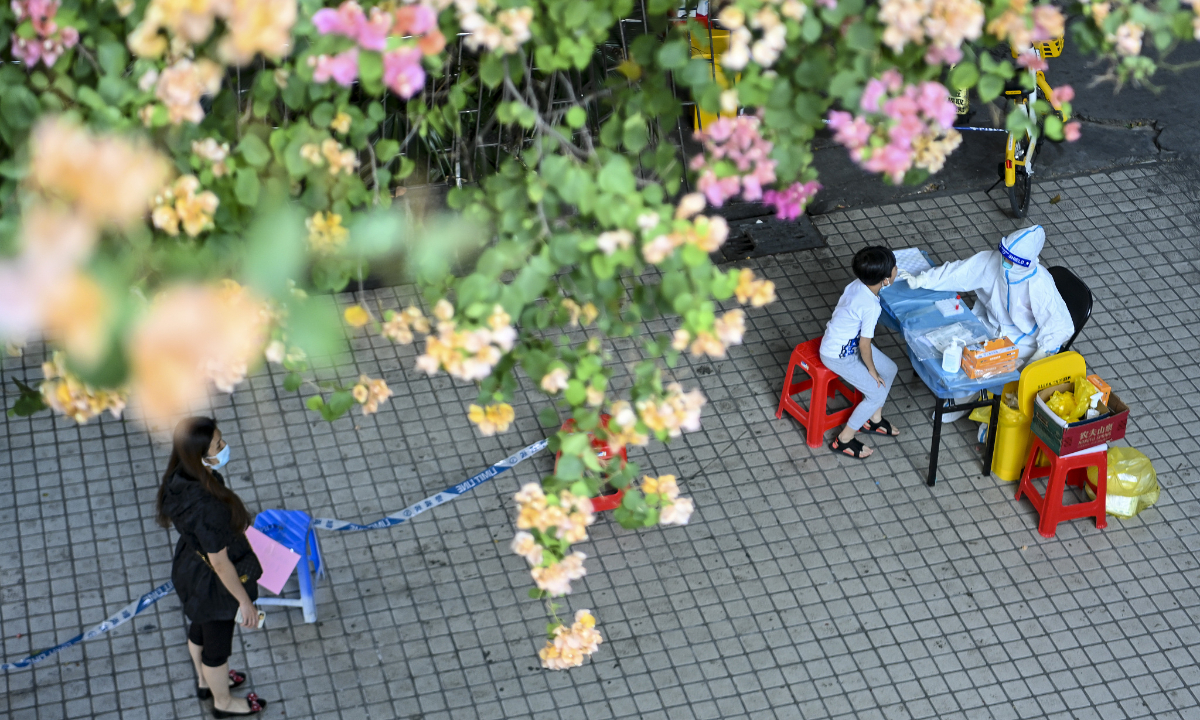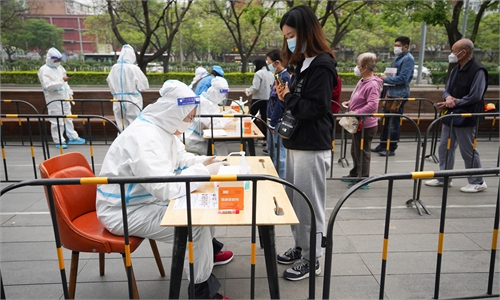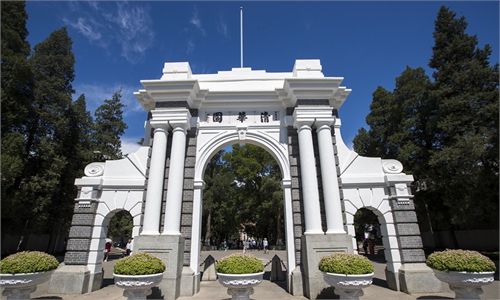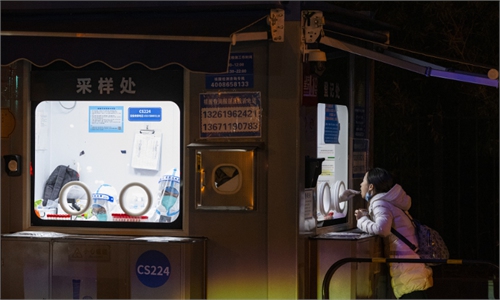Precision urged as cities roll out optimized COVID response
Experts stress readiness for surging cases as winter approaches

Residents take nucleic acid test of COVID-19 in Guangzhou, South China's Guangdong Province. Photo: VCG
China's top health authority has dispatched working groups to supervise local authorities in implementing the ninth edition of China's COVID-19 control protocols and the 20 optimized measures to curb the spread of outbreaks more resolutely while the country may face an extremely challenging winter, some health experts predicted, as the country reported Sunday almost 40,000 daily infections, including 35,858 asymptomatic cases detected on Saturday.The National Health Commission and its national administration of disease control and prevention has jointly dispatched working groups to rectify some problems that have emerged when the 20 optimized measures for combating COVID-19 are being implemented. The implementation of the measures require the effective coordination and information sharing among epidemiological investigation, transferring positive patients and testing groups and taking the first 24 hours as a primary opportunity to contain the outbreaks, Wang Liping, a research fellow at the Chinese Center for Disease Control and Prevention (CDC), was quoted as saying during the weekend.
However, when implementing epidemic control measures, two polarized yet erroneous tendencies have emerged - either a complete lockdown or a "lying flat," meaning no pandemic precautions at all. The joint prevention and control mechanism team of the State Council has promoted strict and determined correction of a "one-size-fits-all" approach and excessive policy steps, Wang said.
Some cities and provinces have issued orders to prevent "one-size-fits-all" approaches of any kind, prohibiting local regulators from imposing extra restrictions on some low-risk areas. For example, Zhengzhou, capital of Central China's Henan Province, said on Saturday that a "stay-at-home" order does not mean local residents cannot go out at all. Residents are allowed to go out for medical treatment, emergencies, escape and rescue.
Hefei, capital of East China's Anhui Province, issued a "not-to-do" list of 16 items including not to seal and weld doors for those quarantined at home. If it is necessary to take control measures, these must be accurately defined and should not arbitrarily expand sealed-off areas or prolong the control period, and fire escapes must not be occupied or blocked.
In Beijing's Chaoyang district - the hardest-hit district in the capital amid the ongoing outbreak, restrictions were lifted in 75 high-risk areas as of Sunday 8 am to reduce the impact on residents' livelihoods to the maximum level, the local health authority said. Also, it said that in principle, temporary epidemic control management should not exceed 24 hours. Those measures are in line with the 20 optimized measures.
Avoid 'one-size-fits-all' approach
Coming up with 20 optimized measures for combating COVID-19 is the optimization and improvement of the ninth edition of China's COVID-19 control protocols, and the original intention is to save medical resources, Zhuang Shilihe, a Guangzhou-based expert, told the Global Times on Sunday.
"Those measures are very timely for Guangzhou, as the city has been struggling to fight the outbreak and its medical resources have almost reached the limit," Zhuang said. "But now the pressure on many medical resources has been relieved."
However, in implementing those measures, some local authorities have taken a "one-size-fits-all" approach and excessive policy steps, increasing the burden on local medical resources and residents, and some places have not fully followed the new measures, which has also amplified the impact on economic and public services to livelihoods, some experts said.
To "further explain the 20 measures" for optimizing the epidemic response, China recently outlined four technical documents with detailed regulations governing nucleic acid testing, classification of risk areas, home quarantine and home health monitoring.
According to documents with detailed regulation on nucleic acid testing, classification of risk areas, home quarantine and home health monitoring, local authorities should not roll out mass nucleic acid testing if there is no outbreak. Instead, they should closely focus on key populations.
How to precisely implement the epidemic control measures is also testing local authorities' management and governance, as when the virus becomes much more contagious, it becomes much more difficult to implement the control work, a Beijing-based expert told the Global Times on Sunday.
"On one hand, local authorities hope to contain the outbreak as soon as possible, on the other hand, they are dealing with limited resources and a more complex situation, which may force them to take excessive measures," said the expert who asked not to be named.
Still, some places have been following the 20 optimized measures to meet the needs of people in risky areas in line with epidemic control work. These areas have seen an orderly lifting of the restrictions on some areas.
Urumqi, capital of Northwest China's Xinjiang Uygur Autonomous Region, said it would gradually resume public transport services including railway, civil aviation, buses and taxis from Monday.
Some other cities in Xinjiang are lifting COVID-19 restrictions. Korla and Shihezi announced that normal public order would resume from Sunday.
Beijing and some cities in Henan and North China's Inner Mongolia Autonomous Region are experimenting with self testing of nucleic acid. Sampling is done at home by individuals, with health officials responsible for guidance and sample collection. The new method is considered as fast and convenient, which also avoids time wasting and the risk of cross-infection.
However, some experts have doubts about whether this measure could be effective, saying that other methods might be better. "Nucleic acid testing has a series of collection procedures and specifications, and even some professionally trained medical staff can't meet the full standards," Zhuang said, adding that he also believes more rapid antigen tests should be deployed for general testing.
Challenging winter
China is currently facing a complicated anti-epidemic situation as COVID-19 is spreading in many areas including Southwest China's Sichuan Province and Chongqing, South China's Guangdong Province, Beijing and North China's Hebei Province, among others.
The possibility of more cases in the future is entirely possible, because the virus is more active in late autumn and early winter, Yang Zhanqiu, deputy director of the pathogen biology department at Wuhan University, told the Global Times on Sunday.
"When the virus enters an active period, it means it's difficult to eliminate or at the very least, it will take longer time to eliminate," he said.
A strong cold front will impact most of China from Saturday to the coming Wednesday, bringing low temperatures and snow, according to a forecast from the National Meteorological Center (NMC) of China on Sunday.
The cold front will first lash provincial areas including Xinjiang, Inner Mongolia and Northwest China's Gansu Province. Temperatures in those regions will drop by up to 20 C, and the cold wave will bring temperatures significantly lower than in previous years, according to the NMC.
In face of epidemic resurgence, China's top health authority has called to promote mass vaccination in China, especially the administration of booster shots among the elderly. The measures also urged accelerated research and development into broad-spectrum vaccines and drugs.
Compared with the past two years, China is facing a much tougher battle against the virus, as before the Omicron-triggered transmission, the country was able to deal with independent outbreaks triggered by imported cases, the Beijing-based expert said. "But now, we are dealing with large-scale domestic transmission, so it's important to accelerate mass vaccination, protect vulnerable groups and be prepared for even worse scenarios."



